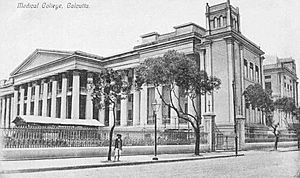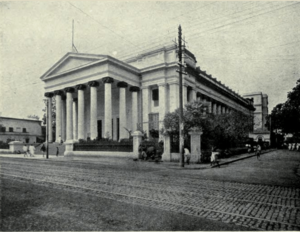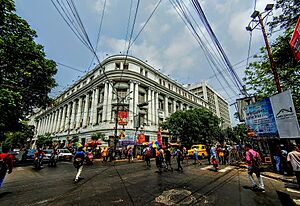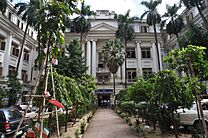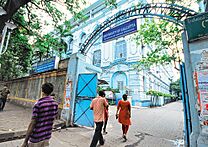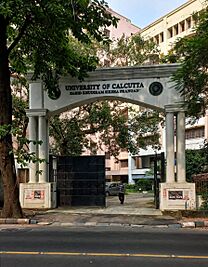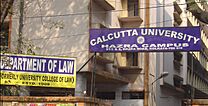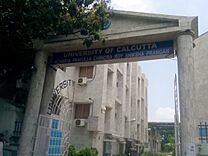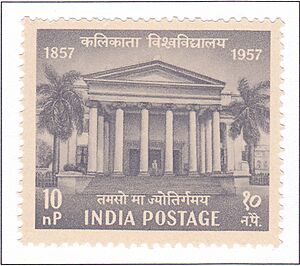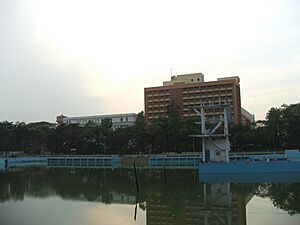University of Calcutta facts for kids

Seal of the University of Calcutta
|
|
| Motto | Advancement of Learning |
|---|---|
| Type | Public State University |
| Established | c. 1857 |
| Founder | Council of Directors |
| Accreditation | NAAC |
|
Academic affiliations
|
|
| Budget | ₹340.73 crore (US$58 million) (FY2025–26 est.) |
| Chancellor | Governor of West Bengal |
| Vice-Chancellor | Dr. Santa Datta (De) (acting) |
|
Academic staff
|
1,206 (2025) |
| Students | 14,053 (2025) |
| Undergraduates | 2,299 (2025) |
| Postgraduates | 8,952 (2025) |
| 2,802 (2025) | |
| Location |
,
,
India
22°34′30″N 88°21′46″E / 22.57500°N 88.36278°E |
| Campus | Metropolis 119.7 acres (48.4 ha) |
| Acronym | CU |
| Newspaper | Calcutta Review |
The University of Calcutta, also known as Calcutta University (CU), is a public university in Kolkata, West Bengal, India. It was started on January 24, 1857. This makes it the oldest university of its kind in the Indian Subcontinent and Southeast Asia.
Today, the university works with 151 colleges and 16 institutes in and around Kolkata. When it first started, its reach was much wider, covering areas from Kabul to Myanmar. The university is highly rated, earning an "A" grade from the National Assessment and Accreditation Council (NAAC).
The University of Calcutta has fourteen campuses across Kolkata. In 2021, it was ranked fourth among Indian universities by the National Institutional Ranking Framework. Many famous people have studied or taught here, including several heads of state, government leaders, artists, and six Nobel Prize winners. These Nobel laureates include Ronald Ross, Rabindranath Tagore, C. V. Raman, Amartya Sen, and Abhijit Banerjee.
The university is also part of the United Nations Academic Impact, which connects universities with the United Nations.
Contents
History of Calcutta University
How the University Started
The idea for a university in Calcutta came from Fredrick John, an education secretary for the British Government in India. He suggested it to officials in London. In 1854, the East India Company agreed to set up universities in Calcutta, Madras, and Bombay.
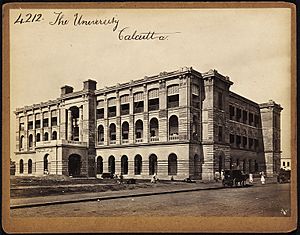
The Calcutta University Act became law on January 24, 1857. A group of 41 members, called the Senate, was formed to make decisions for the university. The land for the university was given by Maharaja Maheshwar Singh Bahadur. When it first opened, the university covered a huge area, from Kabul to Rangoon (now Yangon) and Sri Lanka. It was the first university east of the Suez Canal to teach European classics, English literature, and both European and Indian philosophy.
The first medical school in British India, the Calcutta Medical College, joined the university in 1857. Bethune College, the first college for women in India, also became part of the university.
In 1858, Bankim Chandra Chattopadhyay and Joddu Nath Bose were the first students to graduate from the university. Later, in 1882, Kadambini Ganguly and Chandramukhi Basu became the first Indian women to graduate. The first leader of the university was Governor General Lord Canning.
At first, the university mainly managed exams and connected different colleges. Teaching happened in colleges like Presidency College and Scottish Church College. Because there wasn't enough space, exams were sometimes held in the Kolkata Town Hall or in tents in the Maidan park.
In 1873, a new building called Senate House opened on College Street. It had rooms for meetings, offices, and lecture halls. In 1904, the university started offering postgraduate studies and research. This meant more students and a need for more space.
In 1912, the Darbhanga Building was built with a donation from Maharaja Maheshwar Singh Bahadur. It housed the University Law College. Later, the Asutosh Building opened in 1926, named after Ashutosh Mukherjee, a vice-chancellor. Between 1912 and 1914, two lawyers, Taraknath Palit and Rash Behari Ghosh, donated money to start the University College of Science.
After India's Independence
Before India was divided in 1947, 27 colleges from East Bengal (now Bangladesh) were part of the university. After independence, the Calcutta University Act of 1951 changed how the university was run, making it more democratic.
The university grew, and the old Senate House was taken down to build a bigger, more useful building. In 1957, for its 100th anniversary, the university received a large grant. This helped build the Centenary Building on College Street and the Law College Building.
The Centenary Building opened in 1968. It now holds the Central Library, the Asutosh Museum of Indian Art, and an auditorium. By the mid-1970s, Calcutta University was one of the largest universities in the world. It had 13 colleges directly under its control and over 150 colleges connected to it.
In 2001, the university received a "Five-Star" rating from the National Assessment and Accreditation Council (NAAC). It received the highest 'A' grade in 2009 and 2017. In 2019, the university's main library and 40 other libraries were opened to the public. They have over a million books and many journals and old writings.
University Seal
The university's seal, which is like its official emblem, has changed several times since 1857. The first change happened when the British Crown took control of India from the East India Company. New seals were introduced in the 1930s. The current seal is a newer version of the sixth design. The university's motto, Advancement of Learning, has always stayed the same.
University Campuses
The University of Calcutta has 14 campuses across Kolkata and its nearby areas. These campuses are called Sikhsa Prangan, which means "education premises."
- Asutosh Siksha Prangan (College Street Campus) is the main campus. It handles administrative work and has departments for arts and languages, the central library, and a museum.
- Rashbehari Siksha Prangan (Rajabazar Science College) focuses on science and technology. It has departments like chemistry, physics, and psychology.
- Taraknath Palit Siksha Prangan (Ballygunge Science College) houses departments such as agriculture, botany, geography, and zoology.
- Sahid Khudiram Siksha Prangan (Alipore Campus) is for humanities subjects like history, archaeology, and political science.
- Technology Campus (Salt Lake) is the newest campus. It brings together engineering and technical departments, including computer science and nanotechnology.
Other campuses include Hazra Road, B. T. Road, Viharilal College of Home Science, and the University Health Service.
How the University is Run
Governance and Funding
The university is managed by a group of officers, including the vice-chancellor. They make sure the university and its colleges run smoothly and manage its money. In 2017, Sonali Chakravarti Banerjee became the 51st vice-chancellor. The university gets money from the University Grants Commission, the Government of West Bengal, and other groups for research. It also earns money from fees and selling publications.
University's Reach Over Time
Long ago, the University of Calcutta covered a huge area in British India, from Lahore in the west to Rangoon (Myanmar) in the east and Ceylon (Sri Lanka) in the south. Many colleges that are now famous universities were once part of Calcutta University.
Over time, as new universities were started in other regions, Calcutta University's control became smaller. By 1948, after India's partition, its reach was limited to West Bengal. As of 2020, 151 colleges and 22 institutes in West Bengal are connected to the university.
Some of these colleges include:
- St. Xavier's College, Kolkata
- Asutosh College
- Bethune College
- Scottish Church College
- Maulana Azad College
- Vidyasagar College
Departments and Study Centers
The university has 60 departments grouped into seven main areas:
- Arts
- Commerce
- Social Welfare and Business Management
- Education, Journalism, and Library Science
- Engineering and Technology
- Fine Arts, Music, and Home Science
- Law
- Science
There is also an Institute of Agricultural Science with six departments. This institute helps with farming education and research. It started in the 1950s to teach about agriculture.
The Faculty of Law, also known as Hazra Law College, was set up in 1909. Many famous people, like Rajendra Prasad, have been part of this faculty.
|
|
|
|
Academics and Learning
How to Get Admitted
For undergraduate courses like Arts, Commerce, and Science, students can apply based on their high school exam results. For some subjects, there might be an entrance exam. Students can apply within five years of finishing high school. For engineering courses, admission is based on the West Bengal Joint Entrance Examination (WBJEE) scores.
For master's and doctoral degrees, students usually need to take an entrance exam given by the university or a national-level exam.
Research Opportunities
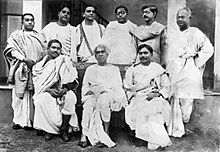
Students can join three or four-year engineering programs. Most programs are yearly, but some are semester-based. Many departments offer master's programs and doctoral programs for research.
The University of Calcutta has a large research center called the Center for Research in Nanoscience and Nanotechnology (CRNN). It opened in 2006. The university has 18 research centers, over 700 teachers, and more than 11,000 postgraduate students.
Libraries and Resources
The main library at the Asutosh Siksha Prangan started around the 1870s. Besides the central library, there are 39 departmental libraries and other libraries across the campuses. Students from connected colleges can also use the central library. The university library has over a million books and many journals, old writings, and patents.
In 2020, the university launched a digital platform called the Institutional Repository. This platform makes the university's research available online for free. This helps researchers around the world access important studies.
Publishing House
The university has its own publishing house called University Press and Publications. It publishes textbooks, journals, and exam papers. It also publishes The Calcutta Review, which is one of the oldest university journals in Asia, started in 1844.
University Rankings
| University and college rankings | |
|---|---|
| General – India | |
| Outlook India (Universities) (2020) | 6 |
The University of Calcutta is well-known globally. In 2023, it was ranked among the top 801–1000 universities in the world by QS World University Rankings. It was also ranked 181st in Asia. The Times Higher Education World University Rankings placed it in the 1001–1200 range worldwide in 2023.
In India, the university was ranked 26th overall by the National Institutional Ranking Framework (NIRF) in 2024. It was also ranked 18th among all universities in India.
Accreditation and Recognition
In 2001, the University of Calcutta received "Five-Star" status from the National Assessment and Accreditation Council (NAAC). It got the highest 'A' grade in 2009 and 2017. The University Grants Commission also recognized it as a "University with Potential for Excellence" in 2005.
The university's Manuscript Library is a "Manuscript Conservation Centre," helping to preserve old writings. The university also has the highest number of students who pass the National Eligibility Test, which allows them to do research with a scholarship from the Indian government.
Student Life
The university has a sports ground and tent in Maidan, where students play various sports like football, archery, and basketball. They also organize inter-college tournaments. The university's rowing club started in 1983.
The Calcutta University Students' Union organizes social and cultural events, such as blood donation camps, environmental awareness programs, and festivals. Most colleges connected to the university have their own student hostels. The university itself has 17 hostels, including eight for women.
University Song
In 1938, the vice-chancellor asked Rabindranath Tagore to write a university song. Tagore wrote two songs: "Cholo Jai, Cholo Jai" (Let's go, let's go) and "Subho Karmapathe Dharo Nirvayo Gaan" (Take up fearless song on the path of good deeds). The first song was used for the university's foundation day. Later, the second song was adopted as the new official university song.
Famous People from Calcutta University
As one of the oldest universities in India, Calcutta University has educated many famous scientists, engineers, world leaders, and teachers.
- Nobel Prize Winners: Rabindranath Tagore, Chandrasekhara Venkata Raman, Ronald Ross, Amartya Sen, and Abhijit Banerjee.
- Artists and Writers: The Academy Award-winning director Satyajit Ray, and the composer of India's national song, Bankim Chandra Chattopadhyay.
- Business Leaders: Sir Rajen Mookerjee, Rama Prasad Goenka, Lakshmi Mittal, and Aditya Birla.
- Scientists and Doctors: Jagadish Chandra Bose, Prafulla Chandra Ray, Meghnad Saha, Satyendra Nath Bose, and Asima Chatterjee.
- Political Leaders from India:
- Fatima Jinnah, a founder of Pakistan, studied dentistry here.
- Subhas Chandra Bose, a nationalist leader and co-founder of the Indian National Army.
- Many former presidents of the Indian National Congress, including Womesh Chandra Bonnerjee and Madan Mohan Malaviya.
- Two presidents of India: Rajendra Prasad (studied) and Sarvapalli Radhakrishnan (taught). Pranab Mukherjee also studied and taught at affiliated colleges.
- Former vice president of India, Mohammad Hamid Ansari.
- Eight chief ministers of West Bengal, including Jyoti Basu and Mamata Banerjee.
- International Leaders:
- Four presidents of Bangladesh.
- Three prime ministers of Pakistan.
- The first president of Nepal, Ram Baran Yadav.
- The first democratically elected prime minister of Nepal, Bishweshwar Prasad Koirala.
See also
 In Spanish: Universidad de Calcuta para niños
In Spanish: Universidad de Calcuta para niños
- Honoris Causa of the University of Calcutta
- List of University of Calcutta people
- List of vice-chancellors of the University of Calcutta
- Education in India
- List of universities in India


